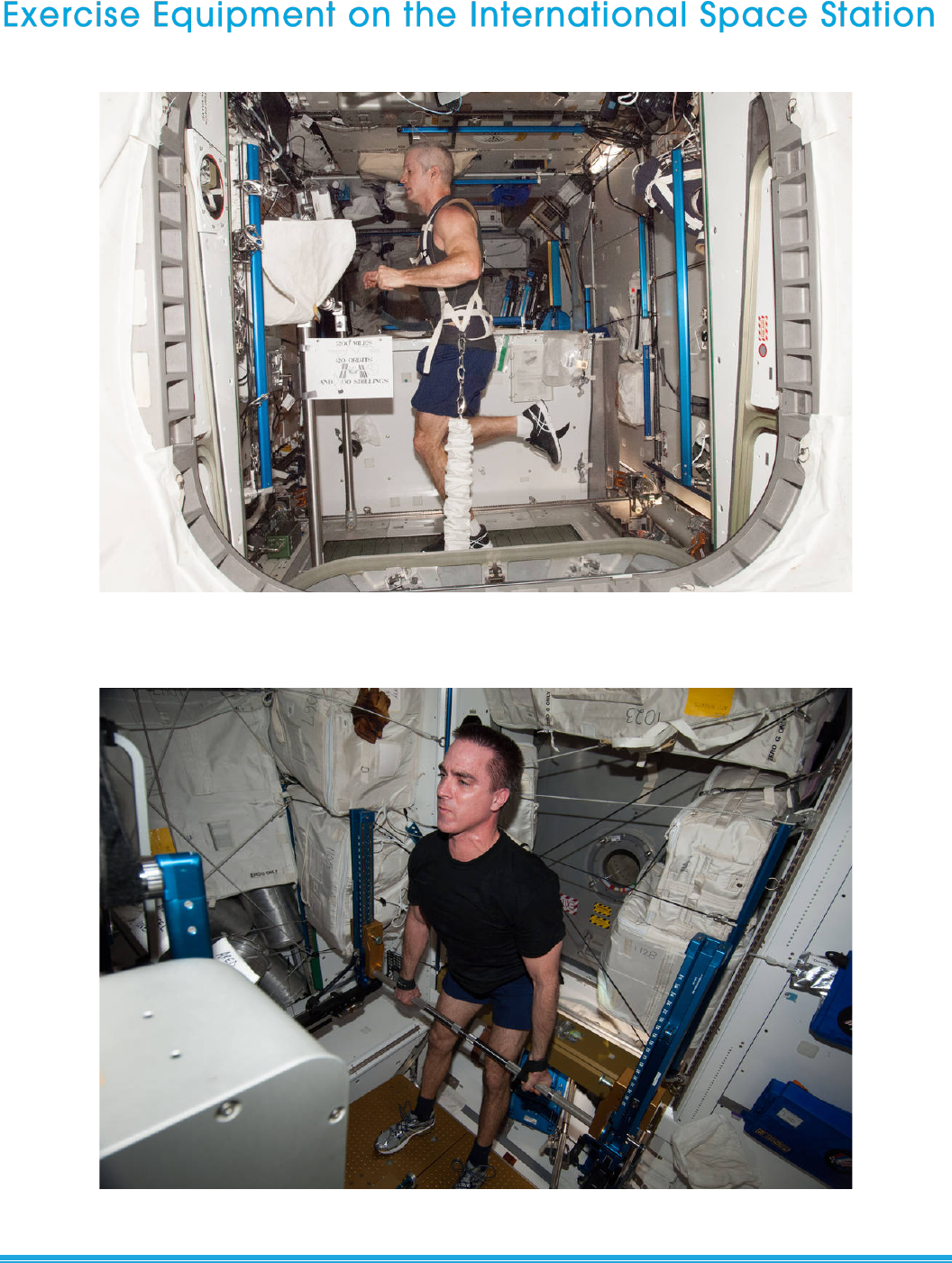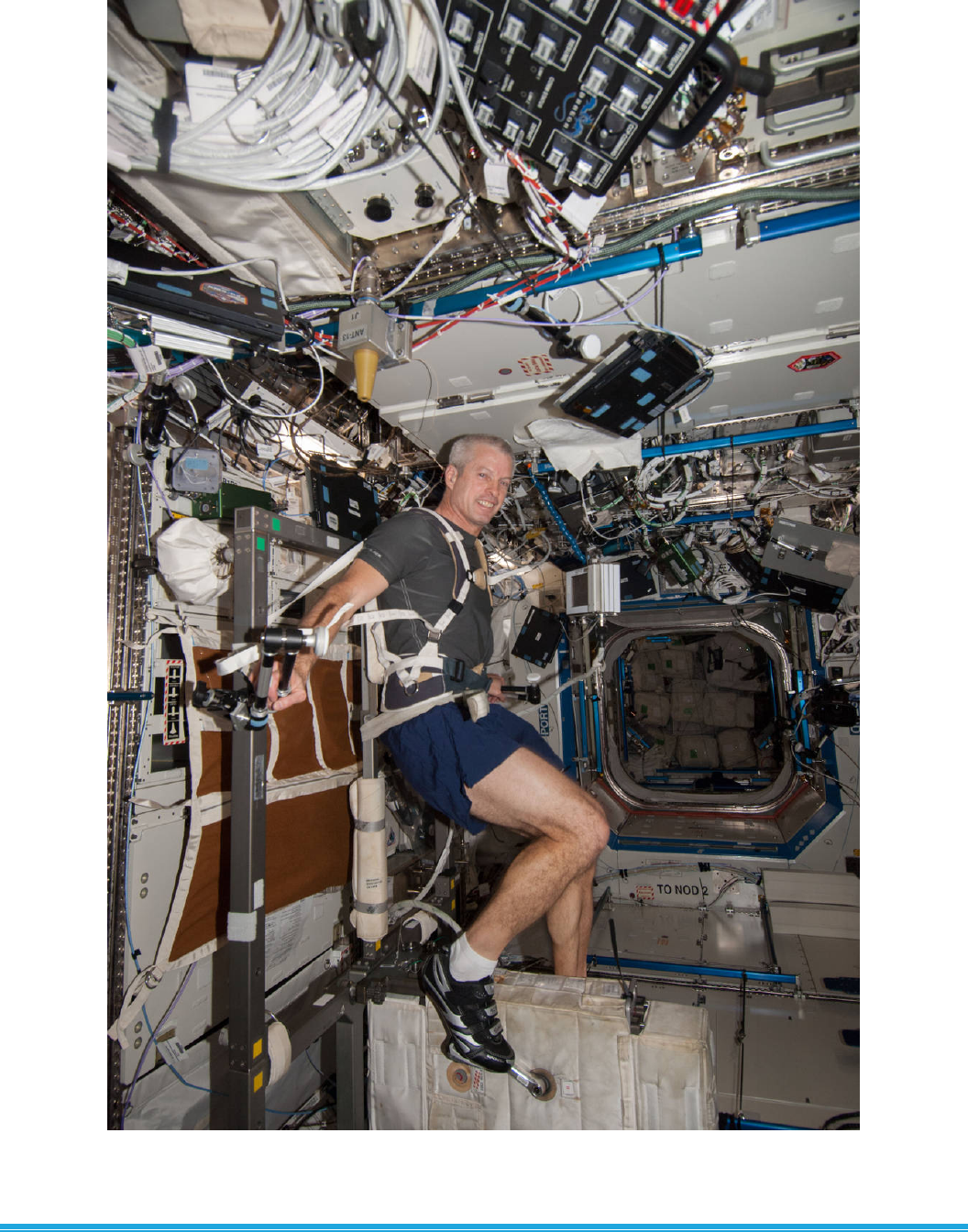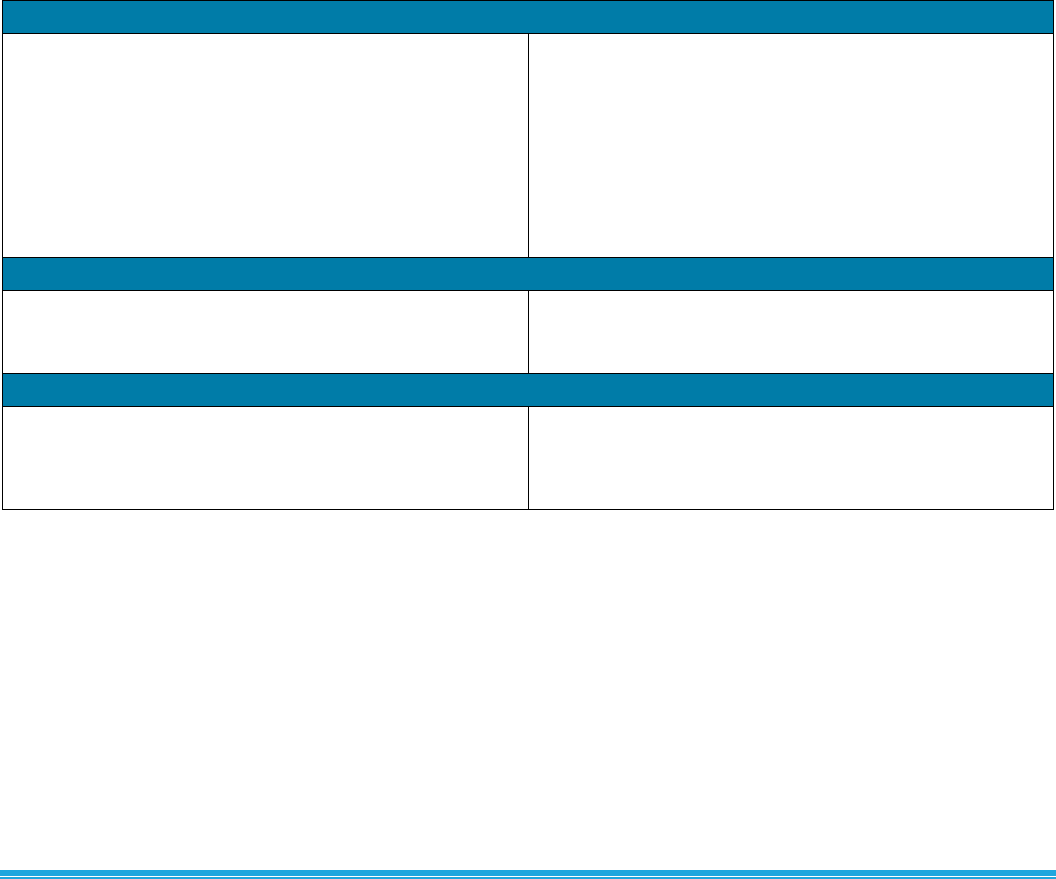
Hazards to D eep Space Astronauts
Activity Four: Gravity
Educator Notes
Students will
• Identify the challenges microgravity poses to the bones and muscles of astronauts in space.
• Determine the fracture threshold of fictitious astronauts.
• Create a design concept for a functional compact exercise device for potential use by NASA.
• Calculate the amount of work being completed by determining force and distance.
Challenge Overview Suggested Pacing
Students are asked to design a functional exercise device that will help mitigate bone loss and 90 to 180 minutes
atrophy during spaceflight. Students will use their knowledge of the skeletal system, osteoporosis,
and the current exercise equipment on the International Space Station to design a new compact
exercise device that is compatible with the spaceflight environment. Students will also create a
hypothetical presentation for NASA.
National STEM Standards
Science and Engineering (NGSS)
Discipli nary Core Ideas
• MS-LS1.A: All living things are made up of cells, which is the smallest unit that can be said
to be ali ve. An organism may consi st of one single cell (unicel lular) or many different
numbers and types of cells (multicel lular).
• MS-PS3-2: Develop a model to descri be that when the arrangement of objects
interacti ng at
a distance changes, different amounts of potenti al energy are stored i n the system.
• MS-ETS1-2: Engineering Design: Evaluate competing design soluti ons using a systemati c
process to determine how well they meet the criteri a and constraints of the problem.
Crosscutti ng Concepts
• Systems may interact wi th other systems; they may have subsystems and be part of l arger
compl ex systems.
Science and Engineering Practi ces
• Asking Questions and Defining Problems: A practice of science is to ask and refine
questions that lead to descriptions and explanations of how the natural and designed world
works and which can be empirically tested.
• Constructing Explanati ons and Designing Solutions: The products of science are
explanati ons, and the products of engineering are soluti ons.
• Obtaining, Evaluating, and Communicating Information: Scientists and engineers must be
able to communicate clearly and persuasi vely the ideas and methods they generate.
Critiquing and communicating ideas individually and i n groups is a critical and professi onal
activity.
Technology (ISTE)
Standards for Students
• Creative Communicator: Students communicate clearl y and express themselves creati vely
for a variety of purposes using the platforms, tools, styl es, formats, and digital media
appropriate for their goal s.
Standards for Students
• Knowledge Constructor
issues and problems, deve
3d: Students
loping idea
build knowledge by a
s and theori es, and pursu
ctively exp
ing
loring
answers
real-wor
and solut
ld
i ons.
Mathematics (CCSS)
Mathematical Practi ces
• CCSS.MATH.CONTENT.6.EE.A.2: Write, read, and evaluate expressi ons in whi ch letters
stand for numbers.
• CCSS.MATH.CONTENT.7.EE.B.3: Solve multistep real-life and mathematical probl ems
posed with positive and negative rational numbers in any form (whole numbers, fracti ons,
Mathematical Practices (conti nued)
and decimals), using tools strategically. Apply properties of operations to calculate with
numbers i n any form, convert between forms as appropri ate, and assess the
reasonableness of answers using mental computation and estimation strategi es.
Challenge Preparation
The educator should
• Read the introduction and background information and Educator Notes.
• Review the worksheets: Bone Mass of an Astronaut, More Work!, Astronaut in Motion, and Exercise Equipment on the
International Space Station.
• Make copies of the worksheets for each student.
• If students will be building their own device, assemble materials or provide a list of materials they can use. (Educators may opt
to have students submit only their design.)
• Have videos preloaded for presentation.
Next Gen STEM 45

Hazards to Deep Space Astronauts
Optional: This activity can be done as an interdisciplinary activity with the physical education department or a health department.
Handouts
• Bone Mass of an Astronaut (one copy for each student)
• Exercise Equipment on the International Space Station (one copy per team)
• More Work! (It is recommended that students complete this individually.)
• Astronaut in Motion (It is recommended that students complete this individually.)
• Scratch paper
Suggested Materials (if students are building their design)
Bicycle tubing or surgical tubing
Cardboard
Cloth (dishrags, cotton fabric that stretches, etc.)
Elastic cord (e.g., bungee cord)
Glue or tape
Goggles and face shield (The student doing the testing of the device may need safety glasses and/or face shield.)
Hole puncher
Rubberbands
Springs (limit the strength and size of the springs; refer to the safety tip below)
Paper cups
Scissors
String
Wooden dowels
Note: This is a suggested list. Students could also have a scavenger hunt and use readily available materials.
Safety
• Limit the strength and size of the spring.
• To prevent accidental release, discharge, or injury, handle with extreme caution.
• Eye and face protection must always be worn during construction and testing.
• Always direct a sharp edge away from yourself and others.
• Before using scissors, discuss safety issues surrounding proper use of the equipment.
• Ensure that students’ device does not contain sharp or pointed surfaces.
• Ensure that the device is sturdy and functional.
• Use caution when students are demonstrating the device.
• Allow for a testing area free of obstruction or hazards.
• Have other students stand back for testing.
Introduce the Challenge
• Provide context for the activity using the introduction and background information in this guide.
• Optional: Prepare for discussion by sharing the following video: “When You Land, Can You Stand?” www.nasa.gov/
content/when-you-land-can-you-stand-one-year-mission-video-miniseries-functional-performance
• Ask students, “Can astronauts walk after spaceflight?” Have them explain why or why not.
• Have students do a simple exercise like jumping jacks until they get fatigued. Discuss whether they think they would be able to
do the same exercise in deep space.
46 Next Gen STEM

Hazards to Deep Space Astronauts
• Discuss what gravity is and how living in different gravitational fields can affect the body.
• Explain that our knowledge about gravity’s effects on the body in deep space is limited because research has been limited to low
Earth orbit.
• Have students complete the Astronaut in Motion worksheet to review the skeletal system.
Astronaut in Motion Worksheet Answer Key:
1. Cranium (skull). 2. Vertebrae. 3. Clavicle (collarbone). 4. Sternum. 5. Ribs. 6. Humerus. 7. Ulna. 8. Radius. 9. Pelvis (hip
bones). 10. Carpals (wrist bones). 11. Metacarpals (hand bones). 12. Phalanges (finger bones). 13. Femur. 14. Patella
(kneecap). 15. Fibula. 16. Tibia (shinbone). 17. Tarsals. 18. Metatarsals (foot bones). 19. Phalanges (toe bones).
• If students need additional scaffolding, they can create a graphic organizer (concept map, spider chart, or KWL chart) that reviews
the following skeletal system vocabulary: bones, cells, vertebrae, skull, ribs, pelvis, femur, humerus, joint, ligament, and cartilage.
• Refer to the background information and discuss with students why bone and muscle loss occurs in the lower body. Discuss how
exercise will help retain bone and muscle mass. Remind students that astronauts no longer use their bones and muscles to help
support their bodies while standing and walking, because they float in space.
– Students can read Bone and Muscle Loss in Microgravity (see Resources) to better understand why the lower body is
affected (no weight load on the lower body in space).
• Review with students the concept of work and force. Review the equation of work: Work = Force × Distance. For example, if a
person pushes a cart up a hill using a force of 500 Newtons and the box is pushed 6 meters, the work will be 3,000 Joules.
Note: Students will be using the work equation for the More Work! worksheet during the Improve phase of the challenge.
• Have students complete the Bone Mass of an Astronaut worksheet individually and discuss their findings as a team.
Note: If students struggle, this worksheet can be completed in teams or in a whole-group setting.
• Explain the role of engineers in designing technology to solve problems. Share the NASA video “Intro to Engineering”
(www.youtube.com/watch?v=wE-z_TJyziI) and introduce the engineering design process.
• Divide students into teams of three to four. Consider assigning roles and tasks to individual students within the group. See the
Teamwork section at the beginning of the guide for suggestions. Distribute the handouts and scratch paper.
• Explain the challenge to students:
– The goal is to design a concept plan and build a functional device that exercises the body to prevent bone loss and muscle
atrophy while also being compact enough for an astronaut to use on a deep space mission. Each team will create a design
concept for their exercise device based on the gravitational field where the device will be used. Students will decide if their
functional compact device will be used on the surface of the Moon (1/6 of Earth’s gravity), in transit to the Moon or Mars
(zero gravity), on the surface on Mars (3/8 of Earth’s gravity), or in all three gravity environments.
– Use the suggested materials list to inform students what materials are available or provide the materials for teams to build
a prototype of their exercise device.
– The device must be sturdy enough for the student to demonstrate the device during the presentation.
– Each team will present their device and explain how it can mitigate bone loss and muscle atrophy.
• Review the following criteria and constraints of the activity with students:
Criteria
Constraints
Exercise device must be functional to strengthen the lower-body skeletal
region (femur, pelvis, and hip).
You may only use everyday, readily available supplies.
Exercise device must be compact, with a maximum height of 42.4 cm, a
maximum width of 33 cm, and a maximum diameter of 21.6 cm (size of a
book bag or standard shoebox).
You may not use any type of free weights.
Total force of the device must be no less than 3 kg and no more than 13 kg.
Prototype must operate for a minimum of 1 minute.
Next Gen STEM 47
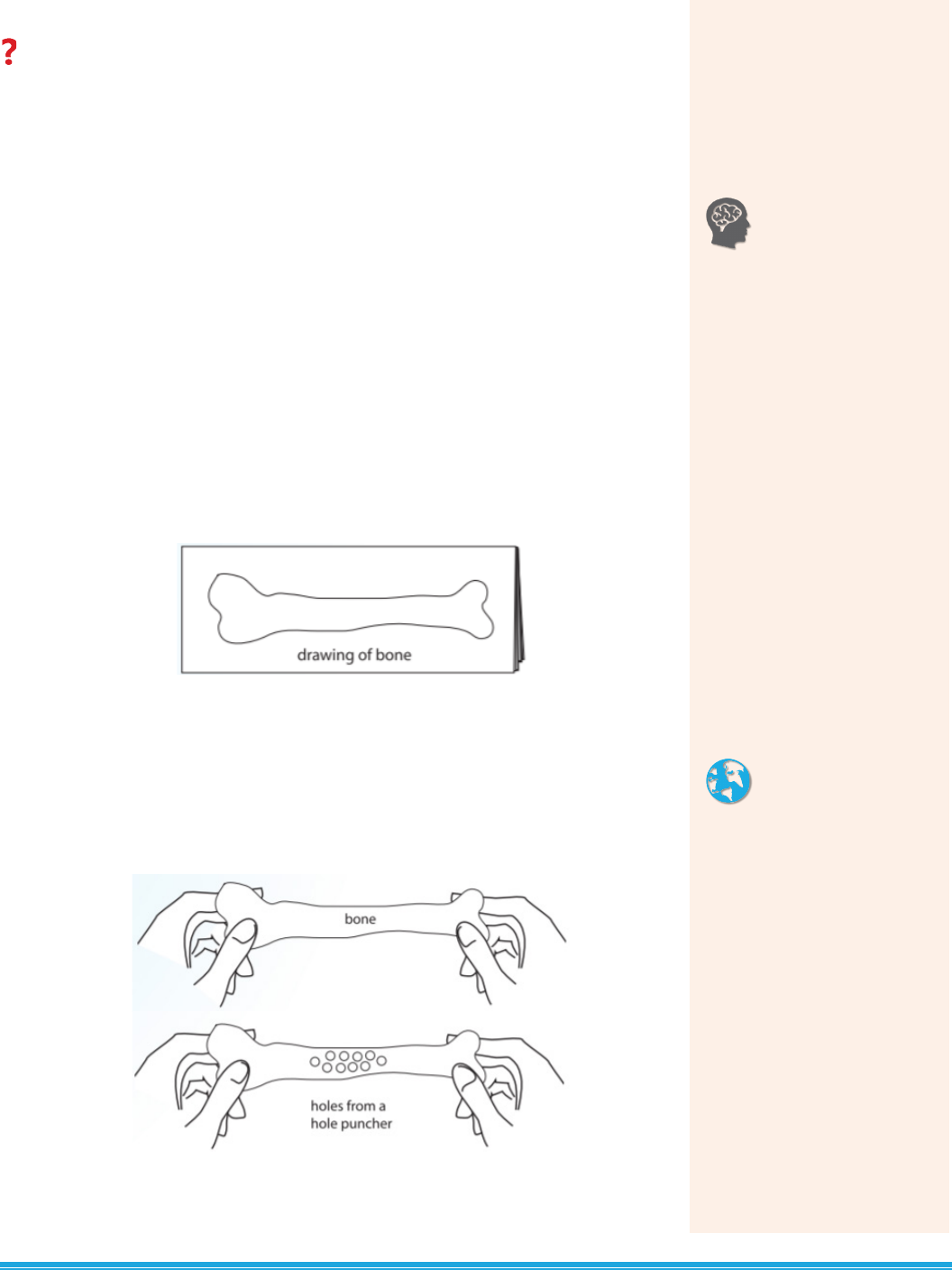
Hazards to Deep Space Astronauts
Facilitate the Challenge
Ask
• Choose one or more of the following clips to share with students:
– NASA Hazards of Human Spaceflight: Hazard 4: Gravity Fields (3:05).
www.youtube.com/watch?v=f3-96ZbY5NA
– Growing Bones in Space. (1:51) www.youtube.com/watch?v=ht9zTT4qPeI
– STEMonstrations: Exercise. (2:43) www.nasa.gov/stemonstrations-exercise.html
• After the clips, engage in a discussion with students using the following questions:
– What challenges caused by gravity do astronauts encounter?
– How would you compare bone density loss on Earth to bone density loss by
astronauts in space?
– Why is bone density loss research so important to people on Earth?
– How would you prevent bone and muscle loss in space?
• Complete the following demonstration with students to understand the problems
associated with bone loss.
– Take a piece of paper and fold it in half.
– Draw a picture of the femur on one half of the sheet. Cut out the picture so there are
now two bones.
• Activate prior knowledge by asking students questions about bones. For example, what
makes up bone? In what body system would you find bones? Why are bones hard?
Note: Emphasize the fact that bones are made of cells and explain how the structure
dictates its function.
• Tug at the first paper bone, or have a student tug at it, to see how many tugs it takes to
tear the paper. Use a hole puncher to create 10 holes in the second bone. Now tug at
second bone to see how long it takes to tear.
• Ask students what happened to the bone after bone density loss.
Share With Students
Brain Booster
Did you know that astronaut Scott
Kelly has a twin? Scott and his
twin brother, Mark, participated in
a twin study to investigate how
microgravity affects different
aspects of the body. Scott was in
space and Mark was on Earth.
This was a unique study because
twins share the same genetic
makeup, so they are physically
similar. The Twins Study was a
340-day investigation conducted
by NASA’s Human Research
Program. Find out how NASA
used 10 billion miles of DNA to
investigate nurture versus nature.
Learn more:
www.nasa.gov/twins-study/fun-
facts
-and-shareables
On Location
Have you ever wondered how
NASA researches microgravity?
The Zero Gravity Research
Facility at Glenn Research Center
has a chamber with a 467-foot
(142-meter) drop that creates a
microgravity environment. Take a
tour of the facility using the link
below.
Learn more:
www.nasa.gov/specials/zero-g/
48 Next Gen STEM

Imagine
• Have students research the gravitational fields that astronauts will experience during the different phases of a spaceflight mission.
– Mars Exploration Program. mars.nasa.gov/all-about-mars/facts/
– Astronaut Begins “Boston Marathon” in Space. (0:59) www.youtube.com/watch?v=nDCdDybegVc
•
Ensure that each team examines the three types of exercise equipment pictured in the handout Exercise Equipment on the
International Space Station.
•
Ask students to individually sketch their exercise device concept. Remind them about the criteria and constraints.
•
After students have drawn their individual sketches, allow students time to examine the available materials.
•
Have students work in their teams to brainstorm how the materials can be used to create a team design that takes into account
the location where the device will be used—whether in transit, on the lunar surface, on the surface of Mars, or in all three
gravitational fields.
Plan
• Have teams sketch a design for their exercise device. Note: Each design must incorporate at least one design idea from each
member.
• Have students label each part with its function and explain how they optimized their design for the spaceflight environment (e.g.,
using lightweight materials, being aware of potential hazards to the astronauts, avoiding loose parts, etc.).
Create
• Have each team construct their exercise device.
• Have teams measure the dimensions of their exercise device to ensure it will fit into a book bag or standard shoebox.
•
Ensure that there are no edges that will cause harm as students test their device.
Test
• Have at least two members of each team test the exercise device to make sure it is functional.
• The device must be functional to complete repetitions for at least 1 minute.
•
Ensure that the device does not cause any safety concerns (loose cords, springs, etc.). Also, students must remember that
everything in space floats, so small parts may be an issue.
Improve
• Have each team identify two areas in which their device could be improved.
•
Allow each team additional time and materials to incorporate changes to their device.
•
Have at least two
team
members use the device for at least
1
minute.
Try to choose
students who did not
perform
the first test.
•
Have students
complete the More Work! worksheet.
Share
• Have students present their device to everyone using a format designated by the educator. Examples: a commercial, a slide
presentation, or an advertisement.
•
Engage students with the following discussion questions:
– How can your device create resistance? Why is that so important in strengthening muscles?
– Identify what gravitational field your device is better suited for and explain why.
– What ways could your device be adapted to enable it to work better in different gravitational fields?
– What flaws did your team identify in the first design? How were these improved?
Hazards to Deep Space Astronauts
Next Gen STEM 49

Hazards to Deep Space Astronauts
– If you could have all the materials you needed, how could you optimize your design to make it as small and lightweight as
possible? Are there other materials that are lighter that could be used?
• Optional: Share students’ results on social media using #NextGenSTEM. Be sure to include the module and activity name.
Extensions
• If supplies are not available, or not feasible, students can just create a concept design (sketch) and present their design.
• Students can use a force plate to demonstrate how much force is being exerted.
• “Get a Leg Up” activity allows students to simulate the fluid shift experienced by astronauts upon entering space.
www.nasa.gov/stem-ed-resources/get-a-leg-up-activity.html
• “Bendy Bones” allows students to see the effect of calcium in building and maintaining strong bones by comparing bone before
and after it is introduced to vinegar. www.nasa.gov/sites/default/files/heo-cpfc-bendy_bones_seg2.pdf
References
Hole-y Bones. www.nasa.gov/pdf/663095main_Hole-y_Bones_Activity.pdf
Bag of Bones. www.nasa.gov/pdf/663094main_Bag_of_Bones_Activity.pdf
Resources
The Human Body in Space. www.nasa.gov/hrp/bodyinspace
Bone and Muscle Loss in Microgravity. www.nasa.gov/mission_pages/station/research/station-science-101/bone-muscle-loss-in-
microgravity/#:~:text=In%20the%20microgravity%20environment%20aboard,during%20their%20stays%20in%20space.
Houston, We Have a Podcast: Hazard 4: Gravity. www.nasa.gov/johnson/HWHAP/hazard-4-gravity
Exercise Countermeasures Lab at NASA Glenn (video). www.youtube.com/watch?v=W8G07FG1g8I
Microgravity Educator Guide. www.nasa.gov/audience/foreducators/topnav/materials/listbytype/Microgravity_Teachers_Guide.html
50 Next Gen STEM
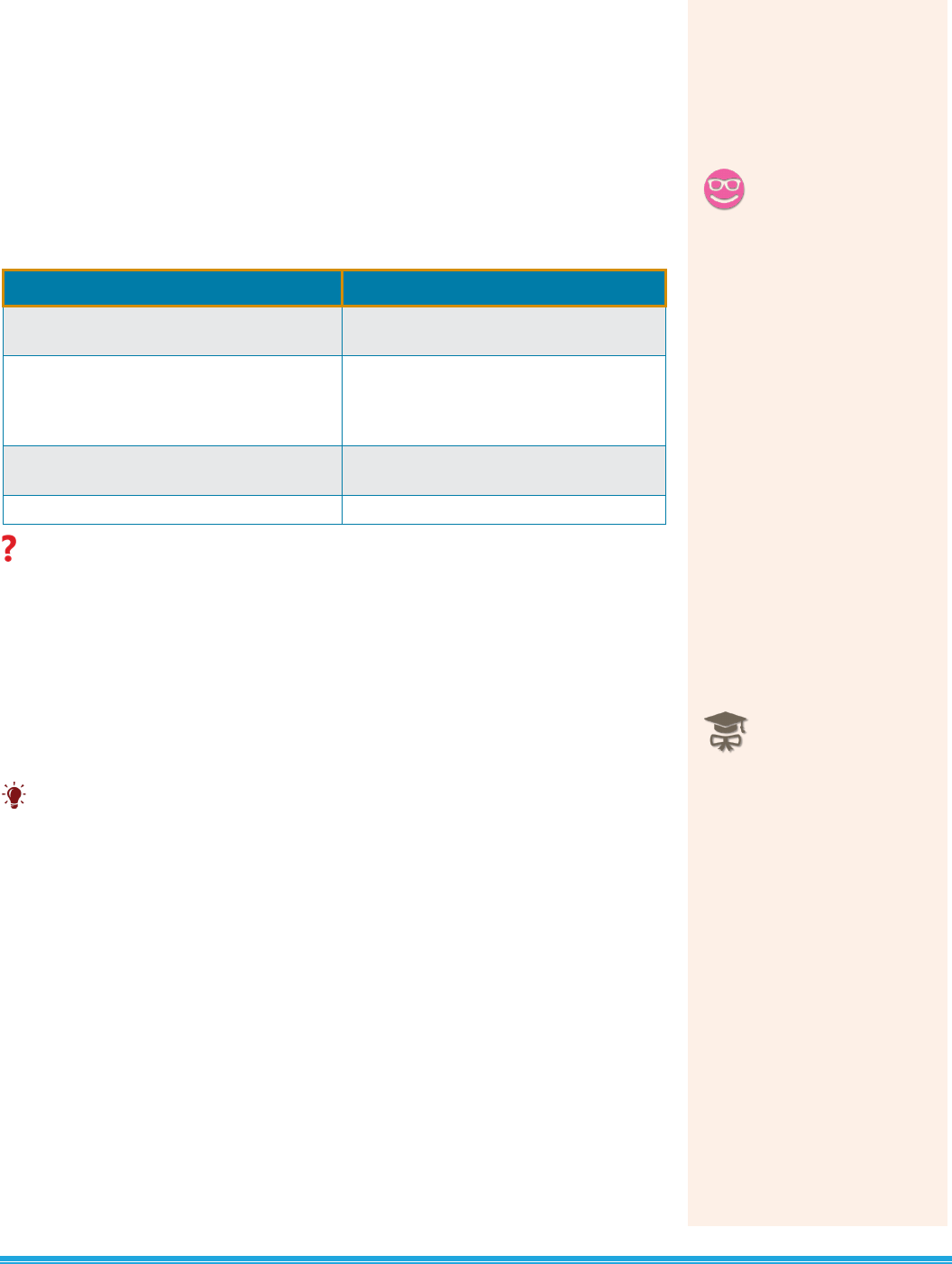
Hazards to Deep Space Astronauts
Activity Four: Gravity
Student Handout
Your Challenge
You will design a functional exercise device that will help mitigate the damage of bone loss
and atrophy. You will use your knowledge of the skeletal system, osteoporosis, and the current
exercise equipment on the International Space Station to design a new exercise device that is
compatible with the spaceflight environment (i.e., compact). You will also create a presentation
designed to show NASA the benefits of the device.
Criteria Constraints
Exercise device must be functional to strengthen the
lower-body skeletal region (femur, pelvis, and hip).
You may only use everyday, readily available
supplies.
Exercise device must be compact, with a maximum
height of 42.4 cm, a maximum width of 33 cm, and a
maximum diameter of 21.6 cm (the size of a book bag
or standard shoebox).
You may not use any type of free weights.
Total force of the device must be no less than
3 kg and no more than 13 kg.
Prototype must operate for a minimum of 1 minute.
Ask
• Discuss the following questions after viewing the video clips that will be shown to you:
– What challenges caused by gravity do astronauts encounter?
– How would you compare bone density loss on Earth to bone density loss by
astronauts in space?
– Why is bone density loss research so important to people on Earth?
– How would you prevent bone and muscle loss in space?
• Complete the Bone Mass of an Astronaut worksheet.
Imagine
• Examine the three types of exercise equipment used on the International Space Station
using the pictures provided. Compare and contrast the similarities and differences of each
machine. How can these machines help strengthen the lower body?
• Research the three gravitational fields (Moon, in transit, and Mars) that astronauts will
experience as they travel in deep space. How will the gravitational fields affect the way
astronauts exercise? Why is it important for the exercise device to strengthen the lower body?
• Use the discussion to decide what gravitational field(s) your device is best suited for. Also,
think about what kind of exercise the device offers. Aerobic? Weight training or resistive?
Combination?
• Sketch a design of what your exercise device will look like.
• Examine the building materials or the list of materials available to your team. Brainstorm
with your team how the materials can be used in your device.
Fun Fact
Did you know that researchers
use mice to research the effects of
microgravity in astronauts? There
may be a protein that can help
build muscle and prevent bone
loss. Researchers sent 40 mice to
live in the International Space
Station and studied 40 other mice
here on Earth. They hope their
Mighty Mice and these proteins
can benefit astronauts in space.
Learn more:
www.nasa.gov/mission_pages/st
ati
on/research/news/rodents-and-
a-rocket-carried-researchers-
dreams-into-space-rodent-
research-19
Career Corner
An exercise physiologist analyzes
patients’ fitness to help them
improve their health or maintain
good health. This is exactly what
an exercise physiologist does at
NASA, but these scientists are
improving astronaut health and
helping to find solutions to the
health problems astronauts may
develop in deep space.
Learn more:
www.nasa.gov/hhp/physiology
Next Gen STEM 51

Hazards to Deep Space Astronauts
Plan
• As a team, sketch a design of your exercise device. Your sketch must include at least one design idea from each team member.
• Label each major part with its name and purpose and note how you optimized your design for the spaceflight environment.
• Be sure to explain how your device is uniquely designed for the gravitational field your team chose.
Create (Only if you are building your device—if you are not building the device, go to the Share phase.)
• Construct your exercise device if your instructor has asked for a prototype.
• Use safety glasses with face shields while handling or extending springs, elastic, cords, tubing, or rubberbands. Use extreme
caution to ensure that any sudden release of energy will be directed away from you and others.
• Measure the dimensions of the exercise device to ensure that it meets the design criteria.
• Ensure that there are no pinch points or edges that will cause harm.
Test (Only if you are building your device—if you are not building the device, go to the Share phase.)
• If you have built your design, have at least two members of the team test the exercise device to make sure it is functional.
• The team members testing must use safety glasses with face shields while testing. All others in the area must do the same.
• The exercise device must be functional to complete at least 10 repetitions.
• Ensure that the device does not cause any safety hazards (sharp ends, pinch points, sudden release of energy from loose ends,
springs, elastic tubing, etc.). Also, remember that everything in space floats, so small parts may be an issue.
Improve (Only if you are building your device—if you are not building the device, go to the Share phase.)
• Identify two areas in which the device could be improved.
• Incorporate the changes to your device.
• Have at least two team members (different from the first test) use the device for at least 1 minute.
• Each team member will complete the More Work! worksheet.
Share
• You will present the device to everyone using a designated format.
• Discuss the following questions as a team:
– How can your device create resistance? Why is that so important in strengthening muscles?
– Identify what gravitational field(s) your device is better suited for and explain why.
– What ways could your device be adapted to enable it to work better in different gravitational fields?
– What flaws did your team identify in the first design? How were these improved?
– If you could have all the materials you needed, how could you optimize your design to make it as small and lightweight as
possible? Are there other materials that are lighter that could be used?
52 Next Gen STEM
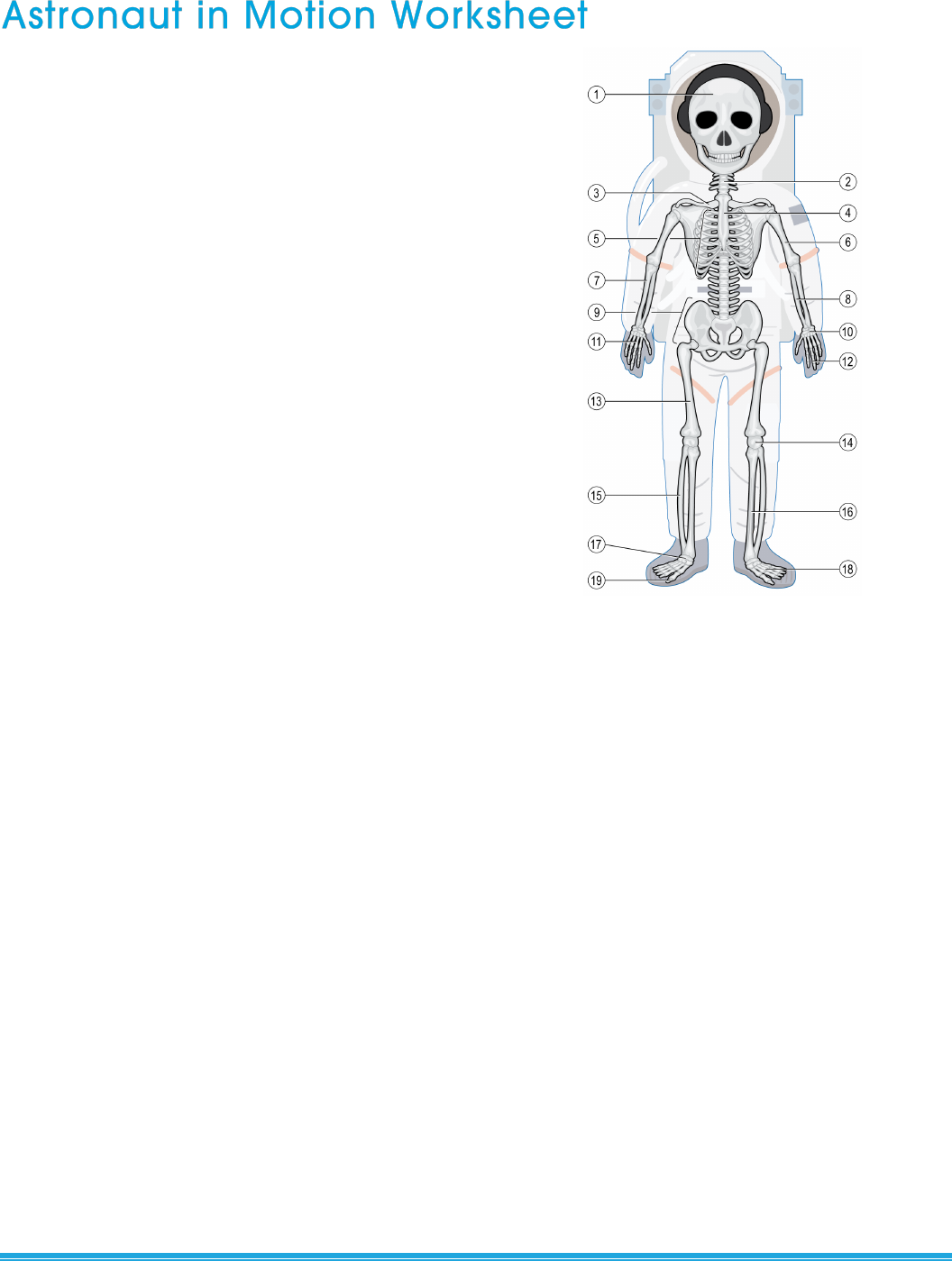
Hazards to Deep Space Astronauts
Astronauts need to exercise to keep their bones strong.
Every astronaut is made up of 206 bones. Bones give the body
structure, protect organs, and much more.
The skull (cranium) protects the most important part of all, the
brain. The cranium is connected to the vertebrae that form the
back. The heart, lungs, and liver are protected by ribs. There
are 12 sets of ribs that run from the backbone to the sternum
(a strong bone in the center of the chest that holds the ribs in
place).
The collarbone (clavicle) has a humerus, which makes up part
of the shoulder bone. Below the elbow, you have the radius and
ulna. So how can you tell which is which? The radius is on the
thumb side and the ulna is on the “pinky side.” The hand is built
in 3 sections: phalanges (fingers), metacarpals, and carpals.
The thighbone is the femur, and it connects to the pelvis (hip
bones) and the knee. Why is the knee important? The knee is
the biggest joint in the body, and it allows the leg to straighten
and bend, so it needs to be protected. The kneecap (patella)
protects the front of the knee.
Below the knee are two bones: the tibia and the fibula. The
tibia (shinbone) is the larger bone and connects the knee and
anklebone. The fibula supports a significant amount of the
astronaut’s body weight—but remember, this does not happen
in space.
A quarter of an astronaut’s bones are found in the feet. There
are 52 bones in the foot. The feet have tarsals (anklebones),
metatarsals (five long bones in the middle of the foot), and more
phalanges (toes).
So how does an astronaut move? Bones meet at the joints that
connect muscles and bones. Joints hold the skeleton together
and allow movement. Muscles work by voluntarily contracting to
make bones move. The bones, muscles, and joints all work
together to get the astronaut moving—even in space.
1. _______________________________________________
2. _______________________________________________
3. _______________________________________________
4. _______________________________________________
5. _______________________________________________
6. _______________________________________________
7. _______________________________________________
8. _______________________________________________
9. _______________________________________________
10. ______________________________________________
11. ______________________________________________
12. ______________________________________________
13. ______________________________________________
14. ______________________________________________
15. ______________________________________________
16. ______________________________________________
17. ______________________________________________
18. ______________________________________________
19. ______________________________________________
Next Gen STEM 53
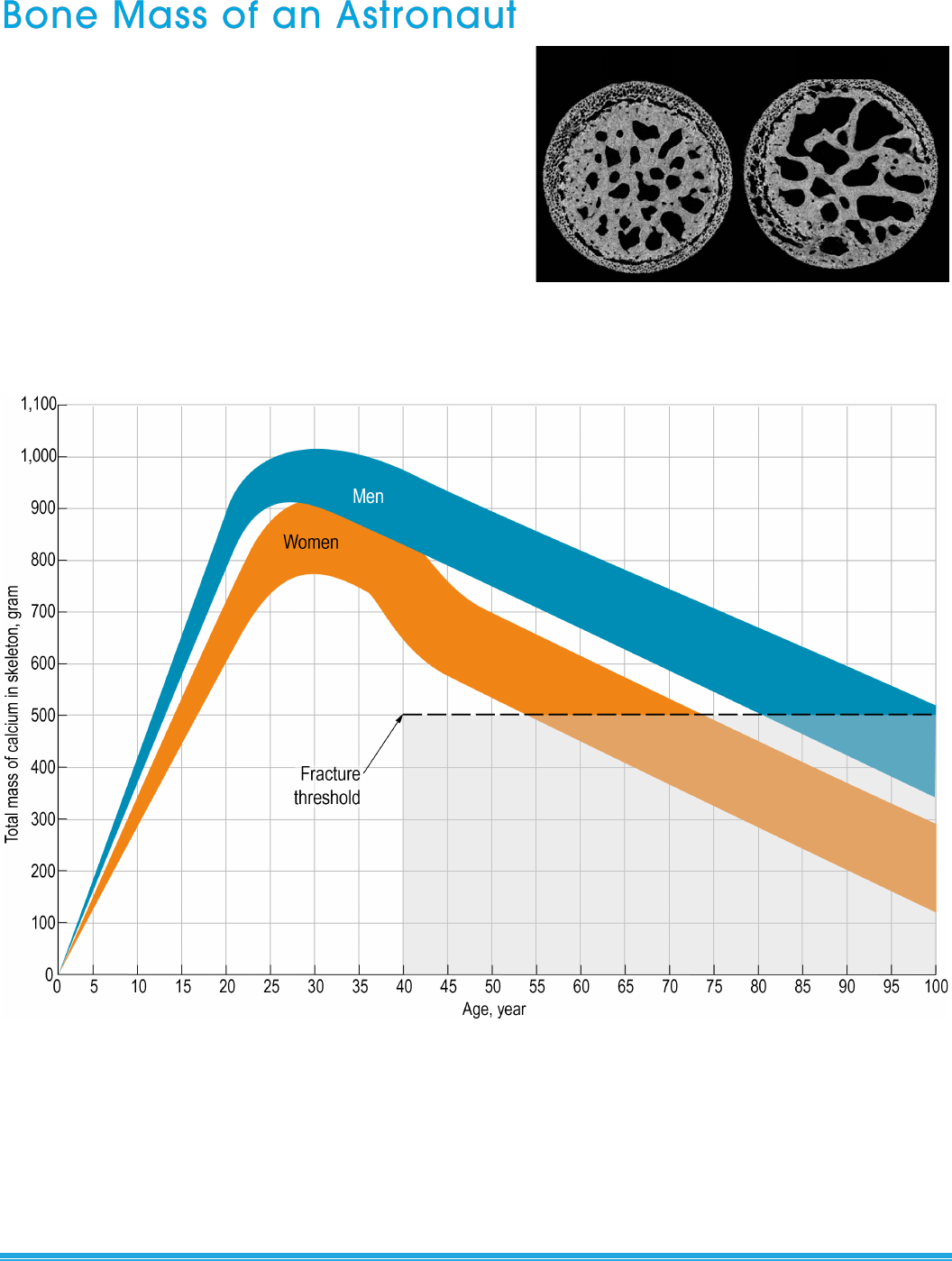
Hazards to Deep Space Astronauts
Breaking a bone is a fairly common injury, but with modern medicine, a
broken bone is usually little more than a painful inconvenience.
Unfortunately, astronauts might not always have a doctor with them
(isolation), and the nearest hospital is millions of miles away (distance).
To make matters worse, the surfaces of the Moon and Mars are rough
and full of tripping hazards (environment). Perhaps worst of all, as far as
broken bones go, is that the reduced exposure to the force of gravity
during spaceflight will cause loss of bone mass, as shown in the cross
sections to the right.
Just as a skinny twig is easier to break than a thick branch, the less mass an astronaut’s bones have, the easier they are to break.
Some bone loss is natural with age, as shown in the graph below. The width of each band shows the typical range of bone mass for
each sex at each age.
1 g
Microgravity
In microgravity, bone mineral loss occurs more rapidly because the bones do not need to resist the force of Earth’s gravity. This bone
loss occurs at an average rate of approximately 1 percent per month. We do not yet know if fractional gravity, present on the Moon
and Mars, will be enough to reduce or prevent that bone loss. In the graph above, the line marked “fracture threshold” separates what
doctors consider to be normal risk for breaking a bone versus high risk for breaking a bone.
54 Next Gen STEM
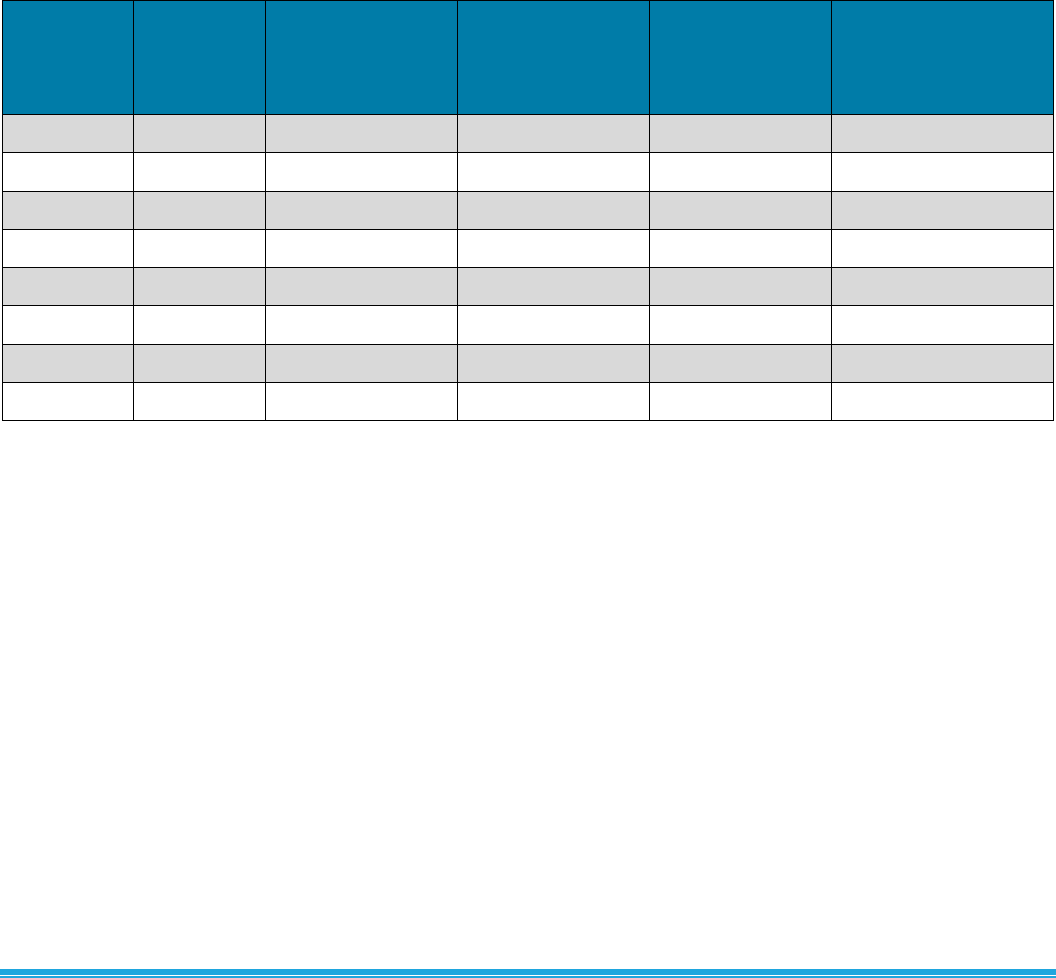
-
Hazards to Deep Space Astronauts
Directions: Complete the table below to track bone mass loss for each of eight hypothetical astronauts on a mission to Mars. For the
purposes of this activity, the fracture threshold for anyone old enough to be an astronaut is considered to be 500 grams of bone mass.
Also, we will assume that people lose just as much bone mass in fractional gravity as they do in microgravity (although NASA does
not yet know if that is actually the case).
Example:
• An astronaut with an initial bone mass of 510 grams (g) will lose an average of 1 percent of their bone mass in the first month.
• Since 1 percent of 510 g is 5.1 g (compute 0.01 × 510 g to get this), this astronaut would have 504.9 g of bone mass (compute
510 – 5.1 g to get this) after the first month.
• A faster way to do this calculation is to realize that if you lose 1 percent of bone mass, you have 99 percent left. So, after the
second month, this astronaut would have 499.85 g of bone mass (compute 0.99 × 504.9 g to get this).
• This astronaut would be at high risk of breaking a bone in as little as 2 months of spaceflight! A fall that would have caused little
more than a bruise on Earth might result in a broken bone by the time the astronaut lands on Mars, let alone by the time they
return back to Earth.
Initial bone
mass,
g
Bone mass
after
1 month
Bone mass
after 6 months
(approximate
travel to Mars)
Bone mass
after 9 months
(after 3 month
stay on Mars)
Bone mass
after 15 months
(approximate
return to Earth)
Does the astronaut ever
have high risk of
bone breaks?
Starting when?
1,000
950
910
865
812
739
621
567
Extension questions:
1. Does an astronaut lose as much bone mass in the 1st month as in the 2nd month? What about the 15th month? Why?
2. If you plot the bone mass of each astronaut over time on a scatterplot, does the pattern follow a straight line?
3. How many months could the typical 40-year-old man or woman survive in reduced gravity without becoming at high risk of bone
breaks?
4. A person with more initial bone mass can withstand the effects of reduced gravity longer without high risk of breaks. Should
NASA hire only people with high initial bone mass? Why or why not?
5. How might the above table change if the fractional gravity of Mars slowed bone loss to just 0.5 percent per month? What if
astronauts stayed an entire year on Mars instead of just 3 months?
Next Gen STEM 55

Hazards to Deep Space Astronauts
Each time you exercise, you are doing work. The work you do is equal to the force you exert multiplied by the distance you exert the
force (Work = Force × Distance). In this activity, you will use distances, forces, and times in order to calculate the work of your
muscles. Remember that one of the problems with microgravity is that astronauts lose up to 20 percent of muscle mass on spaceflights
lasting 5 to 11 days.
Directions
1. Find a clear area free of obstructions and hazards. Others should keep distance while you exercise. Use safety glasses and a
face shield.
2. Using your team exercise device, perform your exercise for 1 minute to determine force and distance.
– Estimate the force that you are exerting. Hint: At the surface of the Earth, 1 pound = 4.45 newtons (approximately).
– Have a team member measure the distance that you exerted the force.
– Enter your measurements on your own data table.
3. Now, perform several repetitions using your exercise device for at least 1 minute.
4. Calculate total work done for each team member who uses the exercise device.
Calculations
As an example, suppose your teammate weighs about 130 pounds, pushes the device 1 meter, and repeats the exercise 10 times.
• Teammate weight = 130 pounds × 4.45 newtons = 293 newtons
• Work in 1 repetition = Force × distance = 293 newtons × 1 meter = 293 joules
• Total work done = Work in 1 repetition × number of repetitions = 293 joules × 10 = 2930 joules
Analysis
1. How does your work output compare with your teammates’ output? Explain why there is a difference.
2. How could the total work done be useful to NASA?
3. If you were able to improve your device, what patterns did you see before and after the Improve stage?
4. Using the information that you calculated, defend your exercise device’s ability to prevent muscle mass loss.
58 Next Gen STEM
